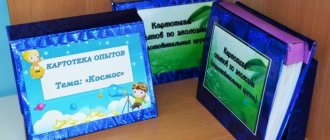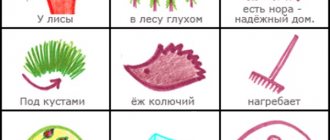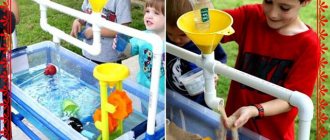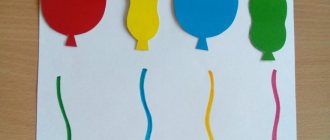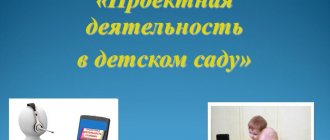The right habits are the keys to success
Adults perform their daily routine tasks easily, “automatically” or almost without thinking. In children, behavior algorithms are also developed subconsciously, based on acquired skills. But not all children develop the right habits; we need to work on this.
The ability to correctly sequence tasks, actions, and events must be developed before school.
Children with extensive experience in various activities
, such as frequent changes of environment, a wide circle of friends, playing various sports, intellectual games, etc., a “rich” system of skills is built. The acquired experience forms basic mental patterns of behavior, the possession of which is very helpful in familiar situations.
But well-developed “thinking with algorithms”
helps to make the best decisions for a person on how to act in a new, difficult, unfamiliar situation.
The use of algorithmic schemes in teaching drawing to children with disabilities
Drawing is one of children's favorite activities. As a rule, children boldly and happily take on any visual means and draw. Unfortunately, this cannot be said about children with intellectual disabilities, since their productive activities, in particular drawing, practically do not occur outside of education. Such children do not show a desire to draw in free activity; they do drawings unwillingly and only at the request of an adult. As a rule, the reason for such reluctance is not so much a lack of interest in drawing as a difficulty in depicting objects.
Relevance:
The visual activities of children with intellectual disabilities are characterized by:
- weakness of associations between one’s own graphic constructions and real-life objects and phenomena;
- difficulty in the process of recognizing real objects in one’s own graphic images and their rapid forgetting;
- abundance of graphic stamps;
- static drawings in form and content;
- poverty of color solutions;
- absence or underdevelopment of plot structures;
Visual activity, in particular drawing, contains great opportunities. It is a means of mental, grapho-motor, emotional, aesthetic and volitional development of children with disabilities. In the process of drawing, all mental functions are improved: visual perception, representation, imagination, memory, mental operations. A characteristic feature in the drawings of children with intellectual disabilities is the use of templates (graphic stamps), which the child transfers from drawing to drawing. Taking into account the peculiarities of development, it is possible to gradually prepare a child with intellectual disability to change and move away from graphic cliches and to develop artistic and creative abilities.
The use of algorithmic schemes in teaching variable drawing
Teaching children the ability to depict objects is one of the most difficult tasks of visual arts work in a correctional kindergarten. Its difficulty is explained, first of all, by the low capabilities of children with intellectual disabilities. Often, teachers, adapting to the capabilities of children, significantly reduce the requirements for the formation of their independent skills in this area. As a result, the majority of students draw only what they have covered in class, using graphic stamps. In the learning process, special attention should be directed to developing in children the ability to depict in a drawing the main features and properties (shape, color, structure) inherent not in a specific object, but in all objects of the surrounding reality. Objects that are depicted by children under the guidance of a teacher should only become the material on the basis of which children will acquire knowledge and skills in order to subsequently use them when depicting other objects. On this basis, children can develop independent visual activities that contribute to their overall mental development. But this requires a targeted selection of teaching methods.
In our work, we chose drawing based on an algorithm for depicting an object as one of these methods.
Since children with intellectual disabilities must first of all be taught to see in an object not only the general shape, but also the shape of individual parts, it is the accuracy of the reflection of the shape of the object that is one of the main conditions for the recognition of the image.
Algorithmic drawing schemes consist of geometric shapes familiar to children (circle, oval, square, rectangle, triangle). When we show a child the algorithm, he recognizes familiar shapes, which, although not perfectly, he can already draw. At the initial stage, together with the child, we consider what geometric shapes the object consists of, trace them with our finger, and also use moving algorithms in our work.
Recognizing the figures, children do not feel a sense of insecurity and fear before drawing, but take up pencils with interest and draw, first together with the teacher, and later, having mastered the experience of drawing according to diagrams, on their own.
At first glance, it may seem that mastering algorithmic schemes hinders the development of a child’s artistic creativity, but this is not the case, since we try to give children as many options for depicting the same object as possible. We also offer children a variety of colors and details.
Thus, the use of algorithmic schemes activates the potential capabilities of children with disabilities in learning to draw and contributes to the formation of artistic and creative abilities.
Bibliography:
1. Kuznetsova G.V. Correctional and developmental classes for teaching graphic skills to children aged 5 - 7 years with developmental problems using art activities (Text) / manual for parents, educators, defectologists. – M., 2002
2. Ryzhova, N.V. Development of creativity in children aged 5-6 years with special needs (Text) / N.V. Ryzhova. – M., 2009.
3. Davydova G.N. Let's draw transport. – M.: Publishing house “Scriptorium 2003”, 2009
4. Shaidurova N.V. Teaching preschool children how to draw animals using algorithmic schemes: A manual for teachers of preschool educational institutions (Text) - St. Petersburg: Publishing House "Childhood - Press", LLC, 2009
Is it possible to develop algorithmic thinking?
The easiest way is to teach your child everything you know and can do, and force him, no matter how trite it may sound, to think before he does. Most children who, even in preschool age, “learn life” together with an experienced adult, according to time-tested algorithms of problems, feel more confident than their peers and cope with any difficulties more easily.
Can you count on school?
In today's world, the development of algorithmic thinking is taken much more seriously than 5-10 years ago. In Australia, teaching the basics of programming begins as early as third grade. Since 2014, similar additional courses for primary grades have been introduced in France. Similar trends are observed in the UK, Finland, Estonia, and Poland: children are taught to understand basic logical constructs and are taught the basics of programming already in elementary school.
In the CIS countries the situation is different, and here parents have to rely primarily on themselves.
To help parents
we have developed an online platform for the development of logical and mathematical thinking. This is an online set of logical problems with theory and comments from experienced teachers and methodologists.
“Good problems don’t just develop the skill of solving similar tasks, but actually teach you to think, to look for the simplest, correct, best way.”
Teaching preschoolers to tell stories and describe objects
Zhuravleva Anna
Teaching preschoolers to tell stories and describe objects
Description is a special type of coherent speech. Classes on teaching description have a diverse impact on the cognitive development of children and the formation of their speech-thinking activity, contribute to the activation of visual, speech-auditory and tactile perception, memory, attention, and observation.
In the process of composing a descriptive story, children learn to identify and compare the essential features of an object, and to combine individual statements into a coherent, consistent message.
For this purpose, it is recommended that step-by-step training be included in the following types of work: preparatory exercises for the description of an object (formation of the lexical and grammatical basis of coherent speech, the formation of initial skills of independent description, description of objects according to the main features, training in a detailed description of the subject (with the inclusion of various features - microtopics) consolidation of acquired skills in composing a story-description, mastering the initial skills of comparative description of objects.
Recommended exercises:
1. Recognition of an object by its description (material from lexical topics, didactic games, toys and dummies of objects is used)
2. Comparison of objects according to basic characteristics (the concepts of shape, color, and other distinctive features are clarified in advance) The use of a parallel description by the teacher and the child of two similar objects is recommended both at the beginning of learning to independently describe, and in the future, if children have difficulties in mastering a sequential plan - scheme. This problem is most conveniently solved in classes like “I’ll start, and you continue.” The success of the classes is largely determined by the correct selection of the toy (it should attract with its unusualness and imagery.) Show the toy to the children 5-7 minutes before the start of the lesson. Then they get the opportunity to take a good look at the object and discover its features. This is an important point, since the child has already been called to tell the story and should not take the toy. It will distract the baby and interfere with concentration.
First, children practice comparing objects of the same type that differ in one characteristic, for example, pyramids of different colors, but the same shape and size; then items belonging to the same typological group (vegetables, etc.) are compared. Before writing a description, all items are named. The teacher draws the children's attention to the differences in objects in appearance. This makes it easier for children to identify the essential features of objects and helps consolidate the corresponding generalizations and contrasts. The object of description is chosen either by the teacher or by the child himself. Subsequently, children move on to comparing objects from different groups, but having one or two common characteristics (tomato, watermelon, ball, etc.)
A technique of parallel description of two objects: cats and dogs.
3.Drawing up descriptions of teacher questions. Toys and other objects with pronounced, easily identifiable characteristics are selected. The teacher teaches storytelling using chains of questions, i.e., a plan that provides for guiding the logic of the child’s narration, description, or reasoning. The story plan can be simple, that is, a linear chain of questions, or complex, that is, with additional chains of questions (prompting or just leading). With children of different age groups, classes are held differently and the requirements are also different. A simple description of an item initially consists of 4-5 phrases. The child’s writing of the description is preceded by a sample given by the teacher.
4. After a series of such lessons, children move on to a more detailed description of objects according to a preliminary plan-scheme (based on visual and verbal material of lexical topics). Conventional symbols are shown as the story-description is compiled, which helps the child avoid omissions and build his story in accordance with the proposed plan-scheme. It is advisable to teach talking about objects and toys with the help of didactic games “Toy Workshop”, “Car Exhibition”, “Demonstration of Clothing Models”. Games require adherence to certain rules. So, if a child did not cope with the task or was poorly prepared for the answer, his order is not accepted (he is not sold a toy, he is transferred from the group of guides to the group of the guide’s students, etc.)
5. The technique of writing letters is effective. These types of work must be alternated. The game is carried out 1-2 times as an independent lesson, and later - as a 5-6 minute part of the lesson.
The letter writing technique is commonly used in teaching storytelling from collective experiences. But it also justifies itself when composing descriptive stories. It is advisable to invite children to correspond with a kindergarten in a city in a different climate zone. The teacher prepares the beginning of the letter in advance, the children give detailed descriptions of animals, birds, toys, etc. The teacher writes down the children's stories and reads them out at the end of the lesson, and the children choose the most successful ones.
6. As you master the skills of describing a directly perceived object, it is recommended to introduce new types of work: describing an object from memory based on impressions received during a visit, during classes to familiarize yourself with the outside world. Topics: My favorite toy. Masha got lost.
According to your own drawing. Drawings are made with colored pencils or felt-tip pens. Then they are placed on a typesetting canvas, and the children take turns talking about the depicted objects. The teacher gives a brief analysis of the children's statements.
Examples of problems from the Logiclike Logic Laboratory
Algorithms help you learn the rules of safe behavior at home and on the street:
Let's learn to think before crossing the road! Find the error in the algorithm...
Using algorithms, it is convenient to learn drawing and other creative arts, and develop attention to detail:
A task to construct an algorithm for creating an application.
If you know the correct algorithm, don’t be lazy and, most likely, you’ll be able to make your own pies:
We have given examples of the simplest algorithms. There are more complex and interesting ones in your personal account.
In Logiclike, children develop logic and thinking, learn to easily and successfully solve basic life “problems” and tasks.
It is quite possible that in 10-20 years, thanks to a good start at an early age
, your children will find themselves in creating new effective algorithms for software solutions and will accomplish something meaningful for themselves and other people.
Register
Login to the site
MAGAZINE Preschooler.RF
A way for a preschooler to become familiar with the concept of an algorithm.“Every person should learn to program because it teaches us to think”
Steve Jobs
Modern children live in an era of active informatization, computerization and robotics. Technical achievements are increasingly penetrating all spheres of human life and arousing children’s interest in modern technology. In accordance with the comprehensive program “Ural Engineering School”, technical creativity and robotics are actively developing in preschool educational institutions. The child gradually gets acquainted with technical creativity; from elementary design he gradually moves on to algorithms, and only then to programming technical models.
Expanding the concept of programming as a process of creating computer programs, the key immediate tasks of which are the creation and use of algorithms.
Algorithmics is a science that promotes the development of algorithmic thinking in children, which allows them to build their own and understand other people’s algorithms. Therefore, in my work, I consider it important to pay attention to the ability to see, understand and use algorithms in robotics.
Algorithmic classes:
- Develop the ability to plan the stages and time of their activities;
- Develop the ability to break one large task into subtasks;
- Allows you to evaluate the effectiveness of your activities;
- They make it possible to literally understand what sequential actions are, moreover, to practically experience the concept of “function”;
- In combination with physical activity, they reduce movement deficits in modern children;
- Increase motivation to understand the world around you.
In my work, I built a step-by-step introduction to algorithms, depending on the age of the children. And so the first year of study is designed for children of the second junior group.
In the second younger group, she carried out preparatory work on the formation of these algorithmic skills; in the process of play activities, preschoolers mastered the norms and rules of behavior at the table during meals, duty in the dining room, rules of washing, cultural and hygienic skills in the use of personal hygiene items with the help of special tips and diagrams algorithms.
The second year is designed for children of the middle group (4-5 years old).
Work at this age is aimed at developing children’s skills to perform linear algorithms. Linear algorithms are algorithms in which all actions are performed once, sequentially, in a given order.
Performing actions according to an algorithm in logic games creates the basis for children to improve their ability to control the progress of solving a game and educational problem, and to improve children’s spatial orientation. Algorithms are also included in all educational areas of preschool education. Games have been developed for each educational area to develop algorithmic skills in middle-aged children. These skills are most successfully developed in a logical game ( “What first, what next” , “Where is the bug hiding” , “Drivers” , “continue the row”, “build according to the algorithm Fist - edge - palm" - successively change three positions: clenched into a fist palm, palm edge-on on the plane of the table, palm on the plane of the table (first with the right hand, then with the left, then with both hands together).
“Pancakes” : the right hand lies palm down, and the left hand palm up; simultaneous change of position with the words: “We played ladushki - fried pancakes, so let’s fry them, turn them around and start playing again .
“Cat” - successively change two positions of the hand: fist, palm (first with the right hand, then with the left, then with both hands together).
The third year of study is designed for older ages 5-6 years. At this stage, linear algorithms are becoming more complex, here you can use games such as a labyrinth, we all know this game and the conditions of the game can be complicated or simplified depending on the goals of the game and the capabilities of the child.
Also at this stage, we teach how to perform not only linear, but also branching, cyclic algorithms. In older preschool age, I begin to introduce children to the use of a cyclic algorithm. This is an algorithm in which a certain sequence of actions is repeated several times until a given condition is met. For example, invite the child to collect toys in a basket, following the proposed algorithm. 1) take one toy and put it in the basket; 2) take another toy and put it in the basket, etc. until all the toys are collected, and then put the basket back in place. There is an introduction to the concept of a cycle and the principle of constructing a cyclic algorithm.
The next stage is getting to know the branching algorithm. This is an algorithm in which some condition is checked; if it is executed, then one sequence of actions is carried out, if not, then another. For example, offer your child help to separate the red and blue balls: 1) take the ball; 2) check the condition - “Is the ball red?” , 3) if yes, then we put the ball in the right basket, if not, then in the left.
To make the work of mastering a cyclic and branched algorithm more interesting for children, you can offer labyrinths using Dienes Blocks. For example, I lay out 8 Dienesh logical blocks in front of the child and, while he does not see, under one of them I hide a “treasure” (coin, pebble, cut out picture, etc.). The child asks me leading questions, but I can only answer “yes” or “no”: “Is the treasure under the blue block?” - “No” , “Under red?” The child concludes that the treasure is under the yellow block and asks further about the size, shape and thickness. We also introduce children to these types of algorithms in research activities.
At this stage, work is underway to develop children’s skills in composing various algorithms. The game “entertaining algorithms” is intended for drawing up an algorithm for the movement route of the performer (any toy). The child needs to lay out the program of the performer’s movement route from the pictograms according to the diagram. To complete the task, the child uses human figures.
Also, the game “Algorithms are entertaining - “Helpers” can be played not only on paper, but also on a special playing floor.
I also use labyrinths to develop logical thinking. A labyrinth is a puzzle with different difficulty options. The child, using a finger, a pencil or small figures, draws along a line from the beginning of the path to the final destination. In my work I use a game called “Floor Algorithm” . The game uses various pictures that are located on the floor. And there is a set of cards with pictures that are used on the playing field. Cards are laid out in front of the child in a certain order with images of those objects along which he will make his way. In conclusion, the teacher and the child review the path traveled. At this stage there is
acquaintance and study of the construction of the first motion algorithms. The child takes on the role of a ROBOT and performs a sequence of his actions.
After preschoolers have mastered the basics of algorithms, I introduce the game “Entertaining Algorithms” . The game is designed to create an algorithm for the movement route of the performer (robot). The child needs to lay out the program of the performer’s movement route from the pictograms in a table according to the individual scheme received. I also use the game: decode the picture of the child using a given algorithm, which consists of a set of geometric shapes and numbers. I have to decode the picture.
Also at this stage, we offer children games for team completion of tasks aimed at developing ingenuity, imagination, constructive skills, and the ability to work in a team. Matrix game - a table containing encoded information. The matrix contains information about the quantities, color and shape of parts needed for construction. While decoding the matrix, the child needs to correlate the information located in the columns and rows. The Bee Bot mini robot teaches children structured activities, develops imagination and offers a lot of opportunities for studying cause-and-effect relationships.
With its help, children get acquainted with programming, give the robot a plan of action and develop various tasks for the robot. These are very exciting and interesting games.
The 4th year of training is designed for children aged 6-7 years.
At this stage, the algorithmic skills acquired by preschoolers in the process of educational and gaming activities, as well as routine moments, are consolidated, and algorithmic activities are applied in various educational areas. Here we use robotics and the Lego WIDO educational environment as an additional element in the formation of algorithmic skills in children 6-7 years old. Children also become familiar with the basics of programming and working with a computer (use of a mouse, knowledge of the main parts of a computer), as well as working with the LEGO Digital Designer program. This program is a virtual Lego constructor. With the help of this program, students learn to create an algorithm, first with the help of a teacher, then independently. The child examines his model in three dimensions, from all sides, and also repeats some stage of the model assembly algorithm.
After mastering the LEGO Digital Designer programs, children move on to mastering the Lego Wido software environment. In which they will be able to apply their knowledge in the field of algorithms, since the program itself is a linear algorithm.
Thanks to the work done, children will master basic knowledge and basic understanding of algorithms, which includes a graphical programming language, create working models of performing robots using objects; demonstrate the technical capabilities of performing robots by creating an algorithm for their actions. and also children can plan their detail and their result. Children actively interact with each other and adults, participate in joint gaming and modeling activities, and technical creativity; they have the skills to work with various sources of information. Children also have a fairly good command of oral speech, are able to explain a technical solution, and can use speech to express their thoughts. Algorithmics is a great way to prepare a child for school.
These games and exercises can be used not only in independent activities, but also at home.
| Next > |
